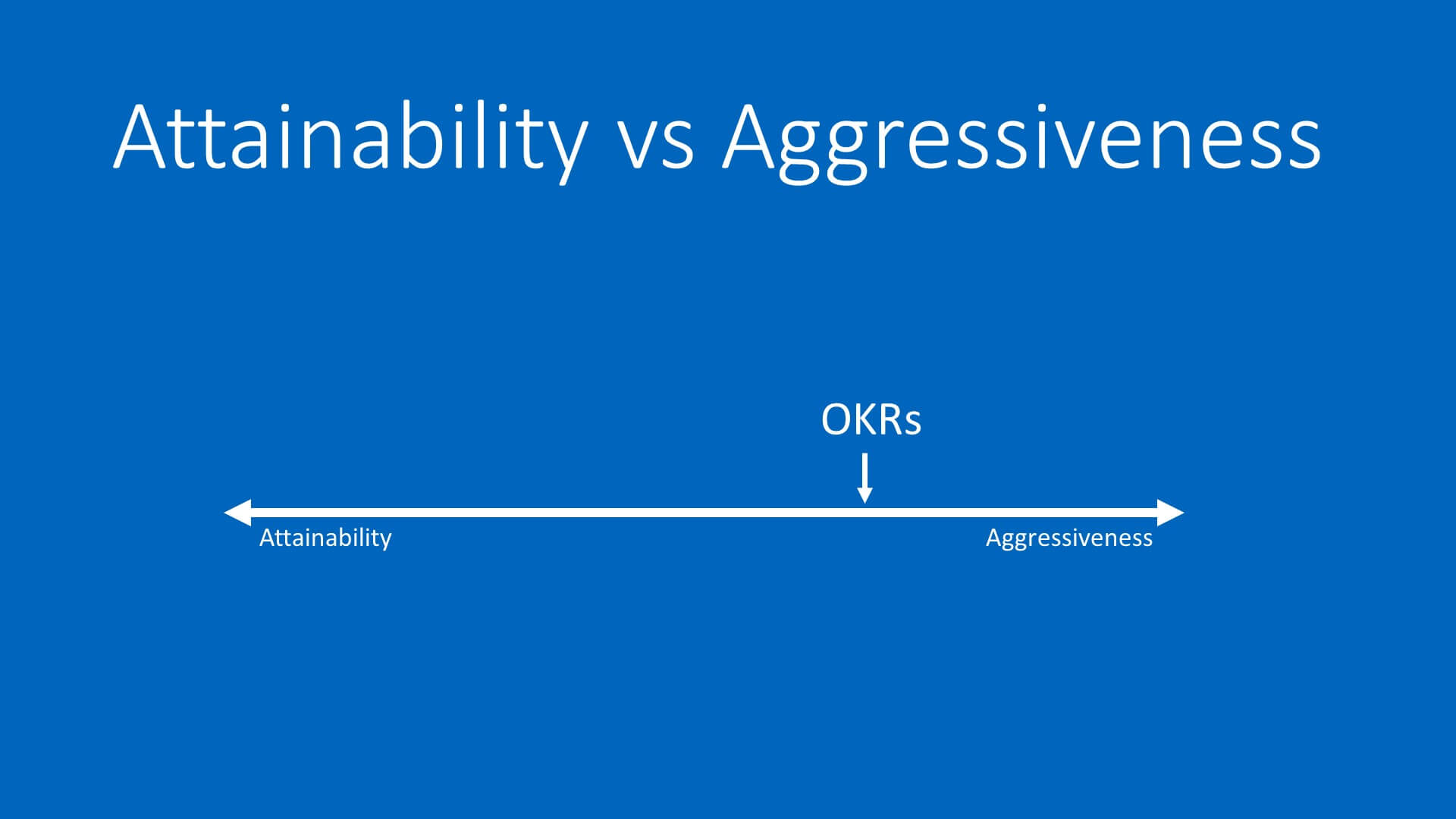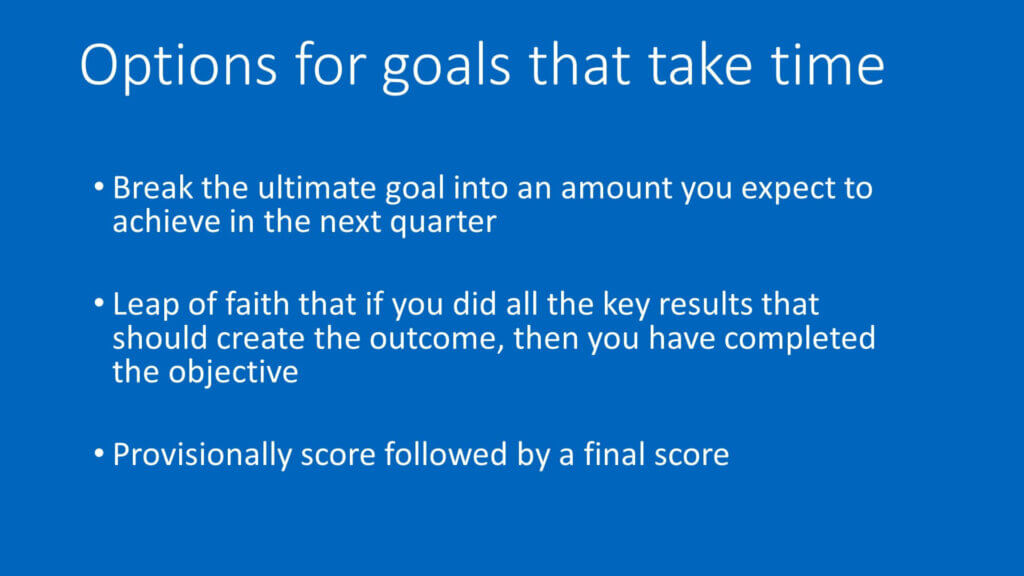What are OKRs (Objectives and Key Results)?
Let’s say you’re driving to a business you’ve never visited. You open up your maps app, enter their address, and the app gives you the directions to get there. You tell the app where you want to go, and it tells you how to get there.
Like a 30-minute drive or a three-year strategic plan, OKRs provide your destination and directions for the next three months. Objectives are where you want to go (i.e., what you want to achieve), and key results say how you will get there (i.e., what you will do to achieve the objective).
The structure of OKRs is very simple. An OKR is comprised of:
- An objective: an outcome you want to achieve
- Key results: the criteria to measure the achievement of an objective
For example, a simple company level objective and three key results might be:
- Objective: Increase customer satisfaction
- Key Result #1 – Customer satisfaction scores are 20% high than last quarter
- Key Result #2 – Customer service staff increases by 5 employees
- Key Result #3 – The percentage of prospects that buy our product/service increases 30%
Key results are short-term measures that define the achievement of the objective, but they can’t encompass the full value of the objective. The value you hope to achieve is determined by your strategic plan, which helps you pick objectives.
Objectives
An objective is an outcome you want to achieve. You do not specify how you will achieve the outcome in the objective; that’s the job of your key results.
Here are some characteristics of good objectives
Significant Value
The purpose of every company is to create value for owners, customers, employees, and other stakeholders. An objective is a significant step toward increasing that value. You can assess an objective’s value by how well it helps you achieve your company’s strategy.
Sometimes, you know all the steps (i.e., key results) you want to take but struggle to crystalize the value. To help find that value, write the key results followed by the phrase ‘so that’ and then finish the sentence. How you finish the sentence is often the value you’re creating.
For example, you may want to gain five client testimonials and conduct three ad campaigns “so that” sales increase 50%.

You can also use a “5 whys” methodology. Start with your key results and ask why you are doing them. Keep asking why until you reach the significant value you want to create.
Let’s return to the testimonials example. Why do you want five testimonials? To provide social proof of your effectiveness to potential customers. Why do you want that? So they trust you. Why do you want that? So those customers pick you instead of other companies. Why do you want that? To increase sales 50%.
Notice the “so that” and “whys” of objectives are intermediate steps to the big “so that” and “why” of your company.” You want sales to increase 50% to serve more customers, to increase profits for owners, and to increase pay and job stability for employees.
Inspirational
Inspiration is closely related to value. You want the objectives to win both the hearts and minds of your employees. You will only achieve the objective and the value it represents with the support of your team. Value must be created for them or someone they care about (e.g., your clients and customers).
Ambitious but Attainable
Objectives and key results are often aggressive yet realistic. They are aspirational as well as inspirational. An objective isn’t inspirational if staff think it’s unattainable. On the other hand, if it’s not ambitious and aggressive, it rarely creates significant value.

In the spectrum of attainability to aggressiveness, objectives usually tend to be aggressive. They are often stretch goals. Objectives don’t have to be highly aggressive, but this reflects the history and champions of OKRs.
For an outcome to be attainable, it should be actionable or controllable by employees. A manufacturing production team may see producing 1,000 more units as more controllable than a sales team that must sell those 1,000 units. Sales amounts can be greatly impacted by competitors, the economy, and the whims of customers.
This can make OKRs feel a bit more process-oriented than KPIs or some other company performance measurement systems. Once again, in the broader context of strategy, OKRs lie more at the short-term tactical end. You can still have other ways to measure larger or longer-term goals.
Qualitative but Unambiguous
There is a tension here. Some people are more comfortable with qualitative objectives. Other people prefer clarity from numerical, objective, and unambiguous objectives.
Qualitative objectives would use terms like “Be the market leader” or “Delight our customers.” Those objectives would then need more clarification and measurement via the key results. In other words, the KRs define what being the market leader is or how the company can measure customer delight.
“The pivot from a qualitative objective to its measurable KR occurs with the magic phrase ‘as measured by’.”
Often “that pivot from a more qualitative objective to its measurable KRs occurs with the magic phrase ‘as measured by’” at the end of the objective. For example, the objective “Be the market leader as measured by:” could have a KR of “growing by 10,000 customers.” The KR would be an amount that would give them the largest market share.
Another question is whether KRs fully define the objective. Those who say objectives are defined by the “as measured by” clause would lean toward scoring objectives as the cumulative score of the KRs. However, some claim that objectives are more than the sum of the KRs. If that is true, the ultimate value of the objective must be stated in the objective since it is not defined by each of the key results or even the sum of the KRs.
In my KPI course, I use the example of “How do you define success for sales?”
- Dollar amount of sales?
- Customer satisfaction scores?
- Amount of repeat sales or new customer referrals
Another way to phrase this is to ask, “what do we mean by sales success?” This answer may be in the objective or defined in or by the key results. Where you define it is less important than making sure to clearly define the objective. Qualitative does not mean unclear.
Many times, company-level objectives are very inspirational, aspirational, or qualitative. Department, team, and individual objectives can also be qualitative, but many times they are more quantitative. Key results from higher levels of the organization become that team or person’s objective.
Time-bound

OKRs are set and reviewed in short time periods, usually quarterly. Results that can be easily observed in this time period are easiest to work with.
This rapid loop can create some constraints in assessing objectives. What do you do with objectives that take time to demonstrate? What do you do with objectives or outcomes that lag the key results that produce them? For example,
• The value, goal, or objective of 10,000 new customers may come well after the advertising campaign that produced them.
• A major new product may take time to gain sales in the market.
• Service improvements take time to improve customer satisfaction scores.
• A major cost-saving project may take months or years until the savings are realized.
What do you do with these types of outcomes?
One option is to break the ultimate goal into an amount you expect to achieve in the next quarter. You may hope to gain 10,000 new customers in the long-term, but set an objective of gaining 500 new customers by quarter-end.
Another option is to take the leap of faith that if you did all the key results that should create the outcome, then you have completed the objective. This suffers from two drawbacks. The outcome is then no more than the sum of its key results. More important, there are many times companies have a hypothesis that “if” they do something, “then” they will achieve something. However, products routinely flop, and marketing campaigns often don’t create the expected sales.
You can give an objective a provisional score at the end of the quarter. Then track metrics over further weeks or months before giving the objective a final score. This is where quarterly OKRs could be paired with annual key metrics or a target threshold of key metrics.

As I mentioned earlier, good objectives are significant steps. It’s usually easiest and best to pick outcomes that are intermediate steps in your longer-term strategy. This allows easier measurement during a short period of time.
Succinct
Short objectives are more inspirational and memorable. They can also be clearer. If you feel you need to provide a few (or more) sentences of explanation, do this on a different document or page than the summary of the OKRs.
Succinct outcomes force planners to prioritize. Long sentences may try to fit too many outcomes into one objective. These objectives are harder to achieve. Their lack of clarity may make it harder to objectively assess whether they were achieved, leading to false victories.
Action-Oriented
Objectives almost always begin with a verb. The outcome is:
• The last action in a series of actions (for example, shipping units after producing them) or
• An action that occurs because of the key results (we put in the work to win the game).

Objectives aren’t complete sentences. The subject/noun is rarely stated, but it’s usually “we,” the company. So, the sentence starts with the verb of what “we” will do. The last half explains the value created.
Recap
I’ve explained in detail the characteristics of good objectives. Here’s a quick recap of them:
• Significant Value
• Inspirational
• Ambitious but Attainable
• Qualitative but Unambiguous
• Time-bound
• Succinct
• Action-Oriented
I’ve also pointed out that there is diversity on how people define and implement OKRs. For example, some promote qualitative objectives while others promote more quantitatively defined objectives. Some say that objectives are scored as a calculation from the key results. Others say scoring the objective involves more than the sum or average of the key results.
Objectives and key results are tightly interwoven, and the boundaries may not always be clear. Key results may define the objective. A result could be either an objective or a key result, depending on its importance and how it’s written. A result at one level of the company may be an objective at another level of the company. We’ll look at key results next.
Key Results
Now that you’re a pro at objectives, I’ll explain how to write good key results.
Let’s return to the definition of a key result. Key results are the criteria to measure the achievement of an objective.
The objective is not merely the sum of its key results. As noted before, it should have more value than the sum of its parts. The phrase “as measured by” that ties objectives and key results is not the same as an equals sign in a formula.
The objective is not merely the sum of its key results. As noted before, it should have more value than the sum of its parts. The phrase “as measured by” that ties objectives and key results is not the same as an equals sign in a formula.
The phrase “as measured by” also doesn’t mean the key results fully define success. You could achieve all the key results and not achieve the objective.

For example, your objective might have been to win the big game (e.g., state championship, division title, or Superbowl). You put in the work to increase the stats you monitored as your key results. However, this doesn’t guarantee success in a world of uncertainty, luck, and constantly improving competitors.
Business strategy and execution is a set of hypotheses and tests of those hypotheses. We want to achieve objective “Y” and think key result actions “X” will get us there. To state that as a hypothesis, we believe that if we do “X,” then we achieve “Y.” Not all hypotheses prove true.
Even a disproved hypothesis is useful. We learn something. In the short cycles of OKRs, we learn things quickly. Every quarter we adjust and refine KRs to achieve our objectives.
Certain types of key results lead to better hypotheses, better execution, and better learning. Here are some characteristics of good key results.
Objectively Gradable

The key result needs to be measurable so there is no ambiguity in the definition of success and whether it was achieved. This creates clarity during the quarter and when reviewing results.
Teams should know exactly what each word in the key result means. For example, if sales are to increase 10%, is that measured by dollars of sales or numbers of units sold? You can do things that increase one but not the other.
Clarity is often achieved through simplicity. Use words that everyone would understand. Be careful of words that are popular with managers but mean nothing to entry-level staff or production staff.
A result that’s gradable allows the team, and others in the company, to track that team’s progress. That is very motivating. If the team is struggling, it allows others to find ways to support that team. The team may need more company resources or help from members of other teams.
Sometimes people say that a key result needs to be quantifiable. I think measurable is a better word because the word “quantifiable” leads people to think in terms of numbers or things that are easily counted. Your key result may be satisfaction scores. It may be dates or deadlines.
I said that the key result needs to be objectively gradable. Teams or individuals self-assess their results. However, those scores should be perceived as reasonable by others. Company leaders and other departments can’t trust teams that claim false successes.
Ambitious but Attainable
Key results should be ambitious but still attainable. Results that are easily attainable may not create the progress possible through OKRs. They may just be “business as usual.” OKRs should push a company beyond that. Results that aren’t attainable are demoralizing.
Owned
Someone must own each metric. There are a few ways to define “own.” One is accountability. This is the person most responsible for achieving the metric, either as an individual or as the leader of a team.
Another way to define “owner” is the person anyone can go to for information about that metric.
A further form of this aspect of ownership is monitoring whether the metric is the best measure of success. I’ve been part of organizations where we didn’t pick the best metric. We would find that things would impact the metric that had nothing to do with the progress we were trying to track.
The owner should point this out. Everyone can agree to quickly switch to a new metric or consider the metric good enough. Scoring poorly on an imperfect key result can be offset by achieving the objective of that key result.
Independent
Ideally, key results should be independent of each other, and each creates some source of value. Let’s break that down into two pieces.

It would be easy to create key results that are merely a series of tasks. Each KR is then just a step that must be accomplished before the next KR. If you fail on any one of these KRs, you will fail on all KRs that follow that one.
Also, be cautious about KRs for one team that are dependent on actions from another team. This compromises the team’s complete ability to achieve the KR and the objective.
Ideally, each key result should create some value for the company. The company should be better off from each one completed. In other words, something was learned, or something was produced. If not, challenge whether it’s really a key result.
A Mix of Outputs and Inputs
This is related to independence in that your KRs should just be a task list. It should measure the results of actions and not just actions.
Some people say that you should only measure results. Others say KRs can include inputs and outputs. These KRs may be significant things you do to achieve outcomes. A middle ground is that if you do include tasks, they should be significant inputs and efforts to achieve an outcome.
Levin and Lamorte, in Objective and Key Results, recommend looking at the verb that starts a KR to find task-oriented ones. If the verb is a passive one like “help” or “assist,” look to who benefits from this. Once you know who benefits, you can identify the benefit, which is the result you want to measure.
Recap
Like I did with objectives, I’ll recap the list of characteristics of good key results. Good key results:
• Objectively gradable
• Ambitious but attainable
• Owned
• Independent
• A mix of outputs and inputs
Key Results in Extreme Uncertainty
There are times when you may not want to use key results. Sometimes you have no way to estimate the results of your actions. This happens with new companies or new products. What do you use as key results in these circumstances?

This may be a time to rely more on deadline KRs or input KRs. At the end of the quarter, you will learn how those inputs drive outputs. You are then in a better position to set output metrics in future quarters.
A KR could be purely a test of something that you want to learn from. You have an idea of the results, but the testing of your hypothesis is more important than the results. Small failures can be a success. They test an idea before you commit large resources to a massive failure. That knowledge can advance you towards your objective and bigger measures of success.
Do I have an Objective or Key Result?
During my discussion on key results, you may have felt that many of the things I said about them also applied to objectives. How do you know whether something is an objective or a key result?
The answer is not clear, and it’s contextual. The priorities of a company at any time are the context for deciding whether something is an objective or a key result. If quality defects have severely hurt your brand, then quality would rise to the objective level. If that hasn’t been a problem, then quality would be one of many key results to achieving a larger objective.
Some things may be a significant key result or a moderate but important objective for the quarter. Don’t get hung up on categorization. Just put it where you think best and get it done.
For more info, check out these topics pages:
